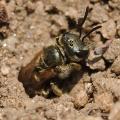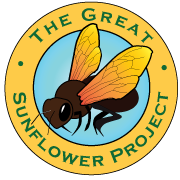


Photos by Hartmut Wisch
Genus summary: Halictus (/hah-LICK-tuss/) is a widespread and abundant genus that occurs in both the New World and Old World. There are about 25 species in North and South America and seven species are known from California. Each of the species found in California is broadly distributed across the western United States and in some cases, Mexico and Canada. Halictus and the closely related genera Lasioglossum and Agapostemon are all called “sweat bees” because they are attracted to human sweat and drink it for its salt content. There is one species in California, Halictus harmonius, which is listed on the Xerces Society’s Red list of endangered insects. This species is found in the San Bernardino and San Jacinto mountains.
Description: Halictus are small to medium sized bees, 0.2-0.6 inches (4.5-14 mm) long in California. They are dark brown to black and many species have a dark metallic green sheen. They have bands of hair on the outermost edge of their tergites of their abdomen. Females carry pollen on brushes of hair (scopa) on their hind legs. Halictus have three submarginal cells in their fore wing. They have a distinctive wing character, the basal vein strongly arched at the base of the vein and if you look at the submarginal cells of the fore wing, all the cross-veins are equally strong which means you can see both edges of the veins. This is different than what you find in Lasioglossum where the cross veins are weak and look like a single line.
Similar insects: Lasioglossum are similar to Halictus but can be distinguished by the location of hair bands on the segments of their abdomen and the thickness of the cross veins of the submarginal cells. Halictus has bands of hair on the outer edge of each segment, whereas Lasioglossum has bands of hair on the inner edge of each segment.
Food sources: Most Halictus are generalist foragers. They use all sorts of genera of plants from the Asteraceae to Scrophulariaceae. They are very common on composites (daisy-like disc and ray flowers) in summer and fall.
Nests: Almost all Halictus in North America are semi-social ground nesters. Daughters in social colonies remain in the nest and help care for the young. Some species have small nests with a single queen and a few workers whereas other species build long-lived nests with multiple queens and hundreds of workers.
Flight season: Individual species can often be seen from spring to early fall. This is due in part to their semi-sociality. A single nest can be established in spring and continue to reproduce through to fall.
Distribution
|
Discover Life -- click on map for details, credits and terms of use. |
